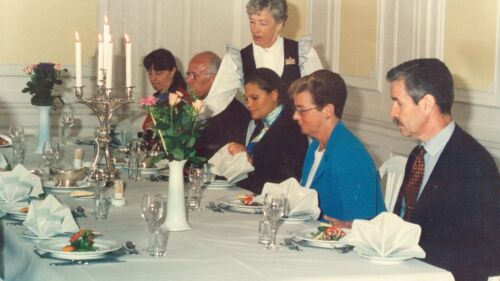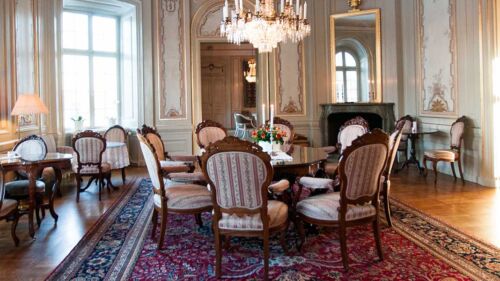Gimo was founded in 1615 as a crown works, but after twelve years it was transferred through tenancy to Willem de Besche and Louis de Geer, who redeveloped the operation with the help of immigrating Walloons.
The de Geer family then became the owner of Gimo in five generations 1640 to 1756. At the end of the de Geer’s ownership Gimo iron-works was highly unprofitable. Furthermore, the de Geer family never lived in Gimo. The modest mansion building was instead during this time occupied by the works inspector.
The Gimo works was sold in 1756 to a successful trading company in Stockholm, Finlay-Jennings Co., which was owned by two immigrated Scotsmen, Robert Finlay and John Jennings. After a couple of years, 1761, Robert Finlay then became the sole owner of the works and he gave the architect Jean-Eric Rehn the assignment to design a whole new mansion building for Gimo. The 17th century modest buildings were going to be replaced by the 18th century bright, French inspired architecture.
The works changed owner again in 1764, it was sold to a director within the East Indian Trading company, Jean Henri Le Febure. Architect J-E. Rehn still continued and in 1767 he made a general plan for the whole Gimo iron-works, where he placed the inspector house at the end of the avenue and gave both the big and the small ponds it’s shaping. A French park was planned in front of the main building and a British park behind it. You can still get a feeling of the latter and its winding paths if you look closely and additionally there is also a rune stone preserved on the mansion property.
Jean le Febure-Lilienberg died in 1805. His widow Margaretha Charlotte Lilienberg then sold the works to one of her son in laws, Axel Didrik Reuterskiöld in 1806. Axel Didrik Reuterskiöld came to own the works until he died in 1834 when it was passed on to his son Carl Leonard. Carl Leonard Reuterskiöld was a very prolific man and during his almost 60 years of ownership he ran and developed not just the forging of the iron but also the agriculture and forestry by new farming and wooden ditches. In 1893 he founded Gimo Walloon Works AB. He died in 1905.
In 1940 Medborgarskolan was founded at Gimo Herrgård and during most of the latter parts of the 1900’s Gimo Herrgård was an educational center for future politicians. Due to the financial crisis of the early 1990’s the center went bankrupt and the manor was taken over by the Skandinaviska Enskilda Banken, SEB.
Günter Schneider and Arne Gustafsson, Arne – one of the founders of today’s Scandic Hotel Chain, and Günter – born in DDR but moved to Sweden in the 1960’s to become a chef and later chain operations director at Scandic, were asked to run the manor for the bank and transformed it into a hotel. The pair reworked the concept and started an incredible journey with restorations, renovations and additions to the hotel. Did you know that the three most successful tournaments for the Swedish national mens’ team in football sine 1958 were all preceded by a pre-tournament camp at Gimo Herrgård – 1992, 1994 and 2004?


